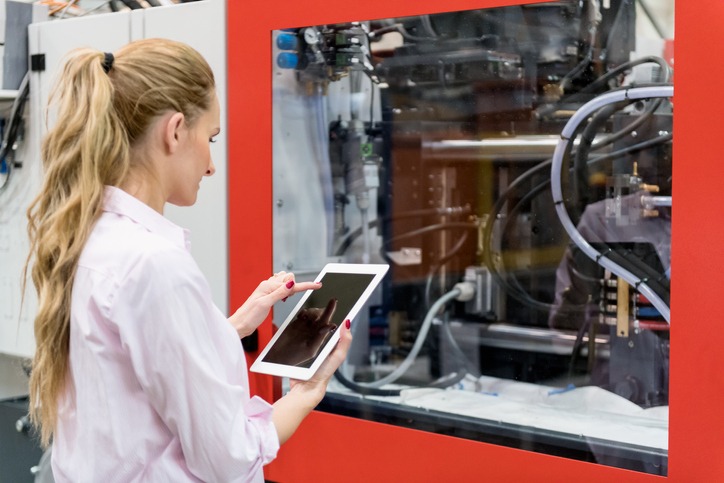IoT for Industrial Manufacturing, sometimes called the Industrial IoT (IIoT), offers manufacturers the opportunity to radically redefine their operations and even their entire businesses.
White paper: Why Industrial Manufacturing needs IoT
What are the main benefits of IoT in manufacturing?
The capabilities of IoT enable manufacturers to gain greater visibility and insights into their operations through the efficient utilisation of data and the tighter integration of disparate systems. This opens up the possibility for manufacturers of moving away from simply selling products to becoming a provider of services and strengthening the relationship they have with the end users of their products.
Therefore there are two main aspects for industrial manufacturers to consider carefully when adopting IoT.
IoT helps manufacturing by improving processes
The first, more straightforward, consideration is how IoT can benefit the business by improving processes, enhancing production efficiency and quality and by helping to introduce greater flexibility into the business. This is essentially an internally-focused efficiency programme and therefore projects can be initiated with clear success metrics in mind.
This is a substantial opportunity for manufacturers to power operational optimisation projects with real-time data enabled by IoT and this is relatively straightforward to achieve by deploying sensors across the manufacturing environment and analysing the data gathered to achieve actionable insights.
The rewards for successful projects are substantial. Consultancy firm Accenture has projected that, by 2030, the optimised production processes that IoT introduces could add US$14.2 trillion to the global economy.
Yet this area of opportunity represents only a part of the advantages IoT can create for industrial manufacturers.
IoT can enable business transformation
The second area for consideration is harder to track and more challenging to implement because it involves large-scale business transformation. It goes to the heart of how an industrial manufacturer sees itself and the extent to which digital transformation will be central to its strategy and therefore requires that more care is taken and greater caution is exercised.

By opening up a means for entire business transformation, the rewards could be even greater than those of generating greater efficiency in the traditional manufacturing business. The questions though, are existential:
Does the company still want to be only a product manufacturer or does it want to bring new services and functionalities to market that open new revenue streams and improve customers’ experiences?
For example, a company that manufactures heavy equipment may no longer sell an excavator to a mining company through a distributor. They may instead sell packages of one thousand operating hours to the customer organisation, selling the excavator’s hole-digging capability as a service, not the excavator itself. This could involve a range of bundled services such as user analytics, data on consumables, data on excavator performance and many other metrics.
Opportunities to upsell and cross-sell other services could proliferate, providing the business with an opportunity to form a stronger relationship with the end customer and also to manage that effectively thanks to the data it collects about how the excavator is being used and how it is performing in the field.
This model could provide a mining company with maximised excavator efficiency because it is not paying for excavators that are standing idle, while at the same time, the excavator manufacturer is gaining insights into how its products are used, when service and maintenance is needed and what design upgrades are required so it can support customers’ needs better.
BI Intelligence estimates that global manufacturers will invest US$70 billion in IoT solutions in 2020 – up from $29 billion in 2015. The firm identifies four top challenges for industrial manufacturers as they upgrade to IoT: threat of cyberattack, difficult determining ROI, technical integration, employee reluctance to implement automation.
Consulting firm PwC, projects US$6 trillion will be spent on IoT solutions between 2015 and 2020. Research from Gartner reports that spending on new IoT hardware exceeded $2.5 million a minute in 2016 – and that, by 2021, one million IoT devices will be purchased and installed every single hour.
How does IoT help industrial manufacturing?
Industrial manufacturing organisations have been challenged for many years in terms of how to operate more efficiently. Under attack from competitors with manufacturing capabilities in markets where labour costs are lower, organisations have been faced with the challenge of relocating or making substantial efficiency gains in their existing factories.
Generating savings in businesses that typically rely on a network of distributors to sell and maintain their products across the world and consequently have a disconnected relationship with their end users means opportunities to access new forms of revenue beyond the initial sale of a product are limited. A race to the bottom on price is of no attraction to shareholders because it offers no prospect of revenue growth as products become commoditised.

Therefore industrial manufacturing organisations must radically overhaul their cost bases and their strategies. IoT can help in both of these goals because of the capability it offers to collect and transmit data from across the manufacturing process. Sensors from the factory floor to the end product can feed vast volumes of data into a central point enabling manufacturing performance data to be analysed and data from the product in deployment to be turned into actionable insights in near real-time.
This means that IoT can offer more than traditional process efficiency improvements on the factory floor. These are important but insights provided by IoT deployments also enable more in-depth efficiency to be achieved by addressing personnel optimisation, environmental and fuel efficiency and increased automation.
At Siemens’ electronics manufacturing plant in Amberg, Germany, for example, machines and computers handle 75% of the value chain autonomously, with approximately 1,000 automation controllers in operation from one end of the production line to the other. Parts being produced communicate with machines by means of a product code, which tells the machines their production requirements and which steps need to be taken next. All processes are optimised for IT control, resulting in a minimal failure rate. Employees are essentially supervising production and technology assets, including handling unexpected incidents.
How is IoT used in manufacturing - From product to service
The efficiencies offered by IoT deployments are helping industrial manufacturing organisations in their wider business transformations. The more accurate, highly detailed performance insights IoT is providing give organisations a clearer picture of the strengths and weaknesses of their businesses and enable the identification of areas for improvement. At the same time organisations are embarking upon substantial digital transformations to prepare their business for the digital, highly automated economy being ushered in by Industry 4.0 and smart manufacturing.
These transformations are at an early stage but manufacturer commitment to digital transformation is strong, reports research firm, Aberdeen Group. Analysis by the firm of recent research has found that 35% of manufacturers plan to achieve digital transformation, with more than 91% of survey respondents seeing manufacturing benefits in deploying IoT.
For industrial manufacturing companies, the next generation of IoT technology will take them far beyond real-time monitoring of machines on the factory floor. The next generation will involve connected information platforms that use data and advanced analytics to create higher-quality, more durable and reliable products. An example of this is with wind turbines manufactured by General Electric. PwC analysis reports that this equipment contains 20,000 sensors that produce 400 data points per second. Immediate, ongoing analysis of this data allows GE and its customers to optimise turbine performance and proactively make decisions about maintenance and parts replacement.
However, the valuable data must be identified in order for useful insights to be generated. Simply collecting data in great volumes doesn’t generate value so industrial manufacturing companies must determine precisely what data is most valuable to collect and how it can be analysed effectively.
Once this has been achieved the possibility for the organisation to radically change strategy starts to become apparent. Some industrial manufacturers will use the greater insights they gain into their products and customers to change the structure of their business to one that involves selling services – such as the use of an excavator as outline earlier – rather than selling products in the traditional way. In an idealised approach, the circle becomes virtuous with more and more insights being collected and the offer becoming more and refined and targeted, delivering real differentiation and avoiding commoditisation.
This is a substantial transformation and one that should not be underestimated. It is still very early days and organisations are still working through early pilot projects and assessing how to change, not just their technology, but their processes and operational mindset for the digital era. Inevitably this will involve substantial disruption and retraining of personnel. In addition, not all industrial manufacturers will embrace the move from product to service. For some, it simply won’t be appropriate and for others the return on investment model may be too unclear.
The difficulty of dimensioning a business that has historically only built and sold products via a distribution channel to become one that provides services via a more direct model, while also accommodating a shift in customer buying from capex to opex may simply be seen as too big a move to make happen effectively. It is therefore still very early days for this type of transformation and for many businesses a more staged approach of individual IoT deployment is favoured. The ultimate goal of digital transformation is very much a future aspiration today but initial steps towards it are beginning to be taken.
Read more about transforming your product to a connected product-as-a service in the white paper.
Show me the money – benefits of industrial IoT (IIoT)
The motivation for deploying IoT in manufacturing environments is, as always, money. This comes in the form of cold, hard cash, through enabling products to be made at lower cost and therefore sold with greater margin but there are equally important benefits also present which ultimately can be equated to money saved. These include savings from maximising worker productivity, minimising energy consumption, saving costs and extending machine life and line uptime through predictive maintenance.
It’s clear that money is there to be saved and made through the deployment of IoT systems but establishing return on investment (ROI) is hard because of the immaturity of the market and the lack of comparable projects to draw projections from. In order to gain a clear idea of ROI, the direct financial savings and the less immediate, softer benefits need to be calculated but this today is more of an art than a science. Some tools exist to aid organisations but more work is needed here to generate accurate ROI profiles.
IoT in manufacturing markets – conclusion
IoT is poised for massive growth in industrial manufacturing as organisations commit to the technology and the advantages it can provide. This innovation comes at a time in which industrial manufacturers are looking to transform their businesses for the digital era and the insights, flexibility and automation IoT can provide them with will help them avoid flying blindly into this new era because of the highly granular, realtime insights IoT empowers them with.
Recent research from BI Intelligence highlights the future scale of IoT in industrial manufacturing. The firm expects the installed based of manufacturing IoT devices to swell from 237 million in 2015 to 923 million by 2020. That near –one billion number of devices demonstrates that IoT enabled devices will become pervasive and the IoT market itself in industrial manufacturing will become one in which many billions of dollars are invested each year.
It’s important that such investment is made to count and generate a positive and expected return if deployment are to keep on track and industrial manufacturers are to go forward in their digital transformations.

